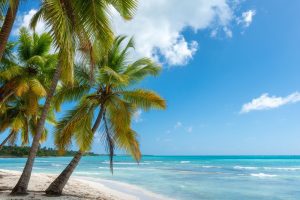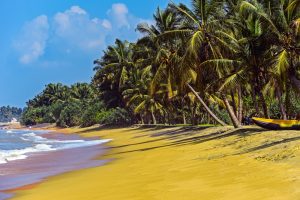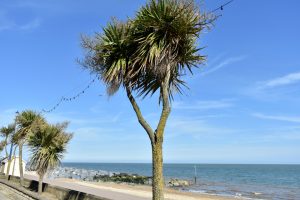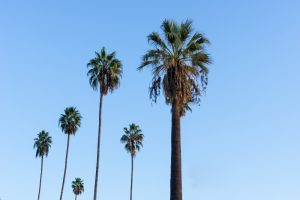Humans have been cultivating and admiring palm trees for thousands of years.
Researchers have traced the oldest palm trees back to areas of Southeast Asia (including some islands in the South Pacific), India, and portions of Northern Africa.
But despite everything that palm trees have in common as far as origin and growing conditions are concerned, palms go far beyond just the tall, skinny varieties that dot tropical beaches and resorts.
While palm trees have become popular ornamental trees all over the globe, most are limited to growing in warmer regions.
There is a lot of diversity between the different species and subspecies, and there are in fact around 2,600 different kinds of palm trees that have been documented.
Here’s a look at 20 of the most common types of palm trees seen in destinations around the world.
Table of Contents
1. Areca palm
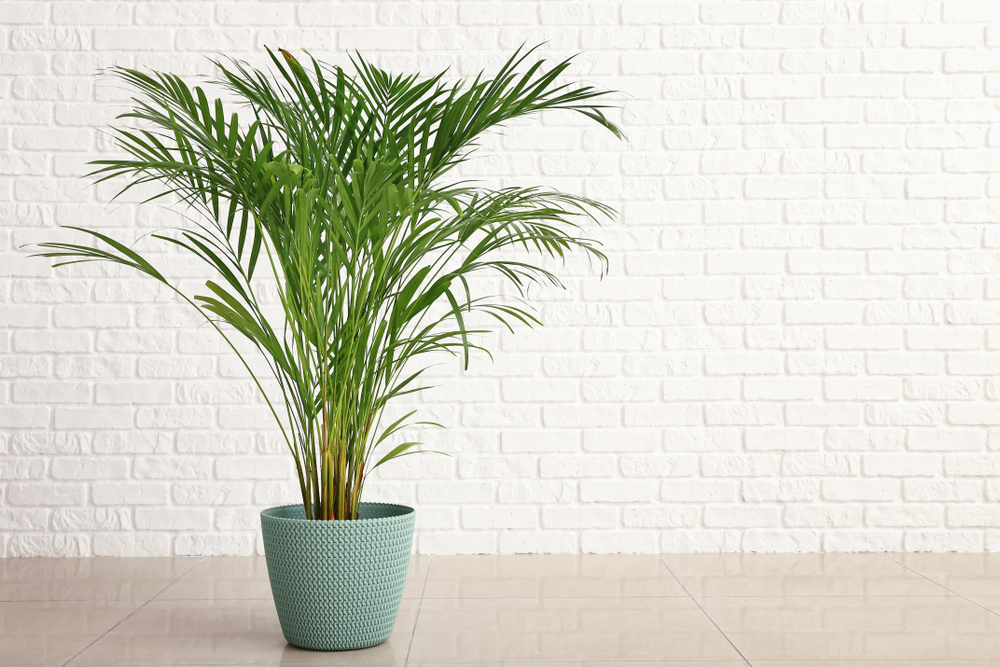
Often used as a decorative indoor plant, the Areca palm (dypsis lutescens) is known for its many thin, feathery leaves that curl upward. In early summer, the palm produces small yellow flowers.
The plant is also a clustering palm, which is indicated by its numerous trunks sprouting up from a single base.
Because of its appearance, the Areca palm has many other names, including the butterfly palm, the golden cane palm, and the yellow palm.
The plant’s flowers can later develop into fruit, which in some regions has become a food source for birds and certain rodents. Adult Areca palms reach between 10 and 30 feet tall.
Though the palm is grown all over the world as an ornamental palm indoors, it is native to Madagascar and naturalized in numerous other warm-weather regions, including (but not limited to) Reunion, Puerto Rico, the Canary Islands, the Andaman Islands, the Dominican Republic, Jamaica, and South Florida.
2. Date palm
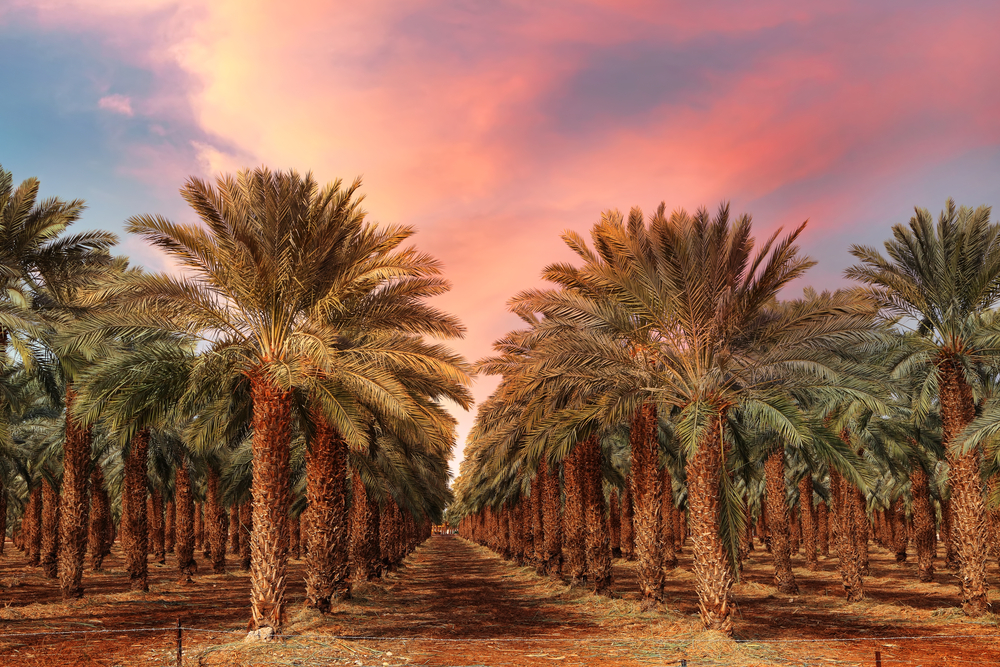
As its name suggests, the date palm (Phoenix dactylifera) is best known for growing a form of sweet, edible fruit known as dates.
Because of this, the date palm tree is widely cultivated in fields for harvesting, well beyond its native habitat of the Middle East and Northern Africa.
As far as appearance goes, the date palm tree can grow up to an impressive 70 feet in height and boasts long leaves that sway down toward the ground.
Trunks can be thicker than other palm tree varieties, but this helps with the natural heaviness of the fruit it grows.
3. Canary Island date palm
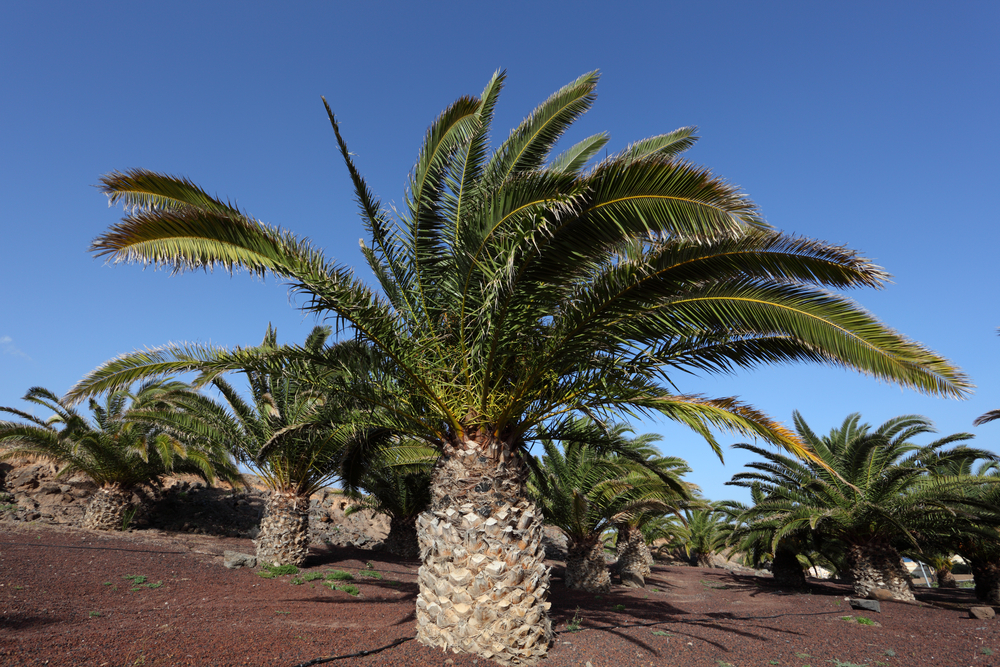
Like the “regular” date palm, the Canary Island Date Palm (Phoenix canariensis) also produces sweet, edible fruit.
However, those from the Canary Island date palm are noticeably smaller in size, and as such, the tree is not as sought-after for cultivation and harvest.
It’s also worth noting that the Canary Island date palm grows a thicker trunk and is shorter than the standard date palm (adults reach between 33 and 66 feet in height).
As a result, it tends to be stockier in appearance than other date palms (and most other palm varieties in general).
Largely viewed as ornamental rather than a practical fruit-bearer, the tree is grown in tropical and semitropical regions around the world, especially when it comes to California and Florida.
Nevertheless, as its name suggests, the Canary Island date palm is native to the Canary Islands, located off the Atlantic coast of northern Africa.
4. Parlor palm
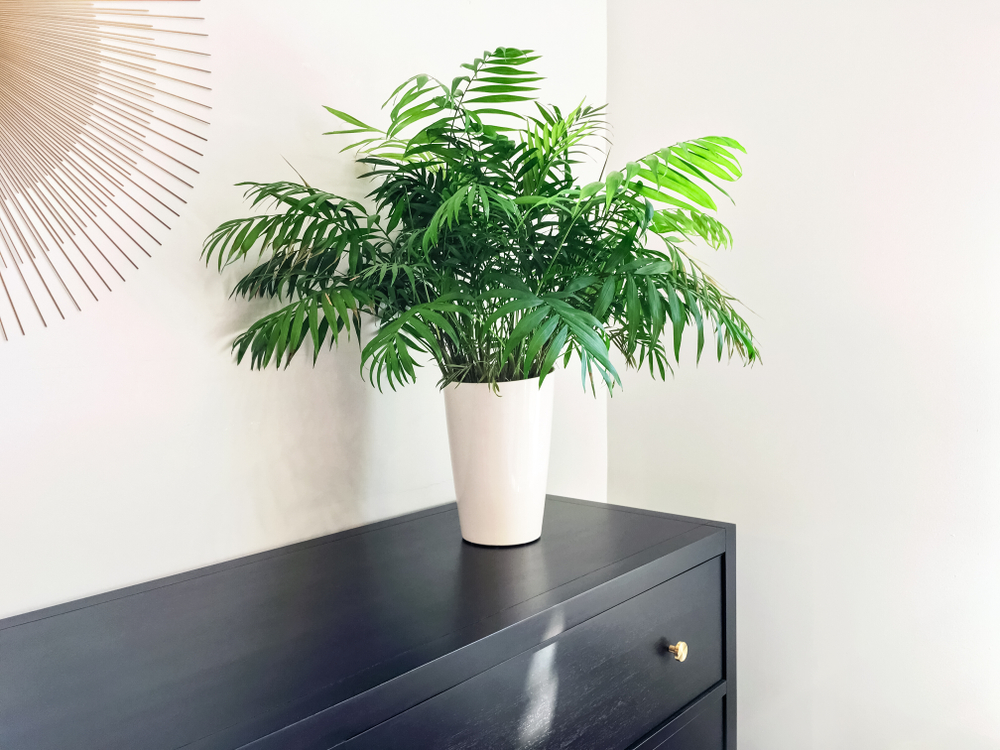
The parlor palm (chamaedorea elegans) is an extremely popular houseplant, but it is in reality a very small variety of palm that is native to Southern Mexico and Guatemala.
Growing naturally on the forest floor, the parlor palm does very well in pots if misted regularly and kept in bright to medium, indirect sunlight.
Heights for parlor palms can vary wildly. While most of the indoor-grown versions of parlor palms don’t reach higher than a few feet, outdoor varieties can reach between 6 and 7 feet tall.
The parlor palm is recognized by its numerous stems with bushy green leaves. Though it will not flower every year, summers can see light yellow or orange-red flowers appear on the parlor palm.
5. Mexican fan palm
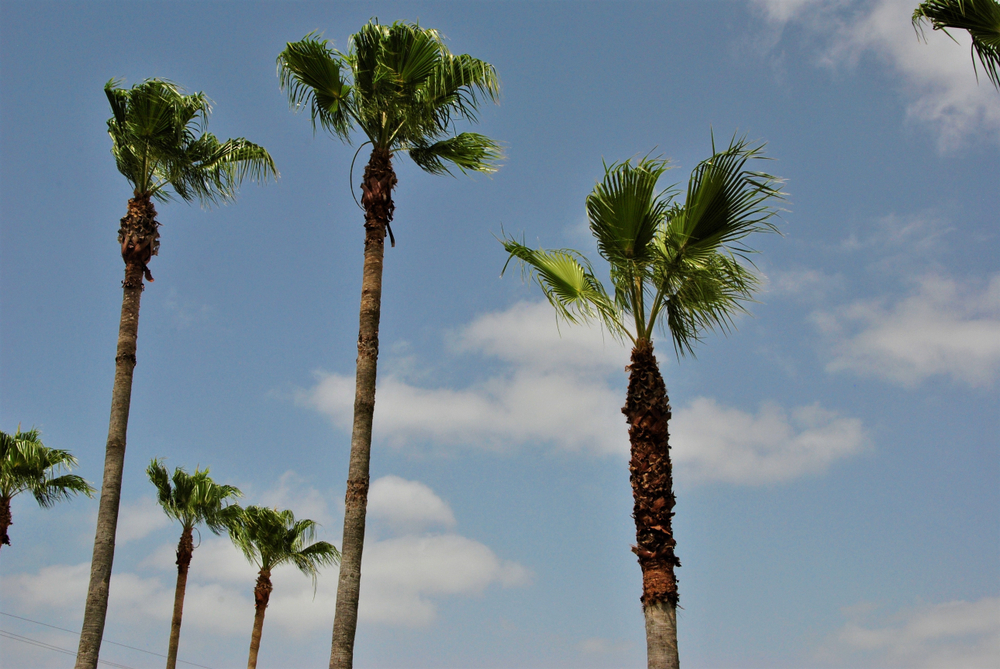
Native to Mexico’s Baja Peninsula and certain parts of Sonora, the aptly named Mexican fan palm (Washingtonia robusta) grows tall and skinny with the appearance of stocky fan-like palms at the top.
The tree grows pale orange-pink flowers that form spherical blue-black fruit, which is edible. The tree’s trunk can appear rough, as past leaf bases can take a while to flake off.
Though native to Mexico, the tree has been naturalized in a variety of other destinations: the United States (including Florida, Texas, California, and Hawaii), Italy, France, Israel, Lebanon, Qatar, Spain, Reunion, and the Canary Islands.
6. Queen palm

With long, feathery fronds and an elegant appearance, the queen palm (syagrus romanzoffiana) is an immensely popular ornamental tree for landscapes and gardens.
Also known as the cocos palm, the tree is native to South America but is now grown in warm regions around the world. In addition to its feathery leaves, the queen palm stands out for its short, slender trunk appearance.
The tree is actually on the tall side (it can reach heights of 49 feet), but its fronds can start growing quite low on the base and then sway downward, giving it an appearance reminiscent of that of other trees with branches.
7. Majesty palm
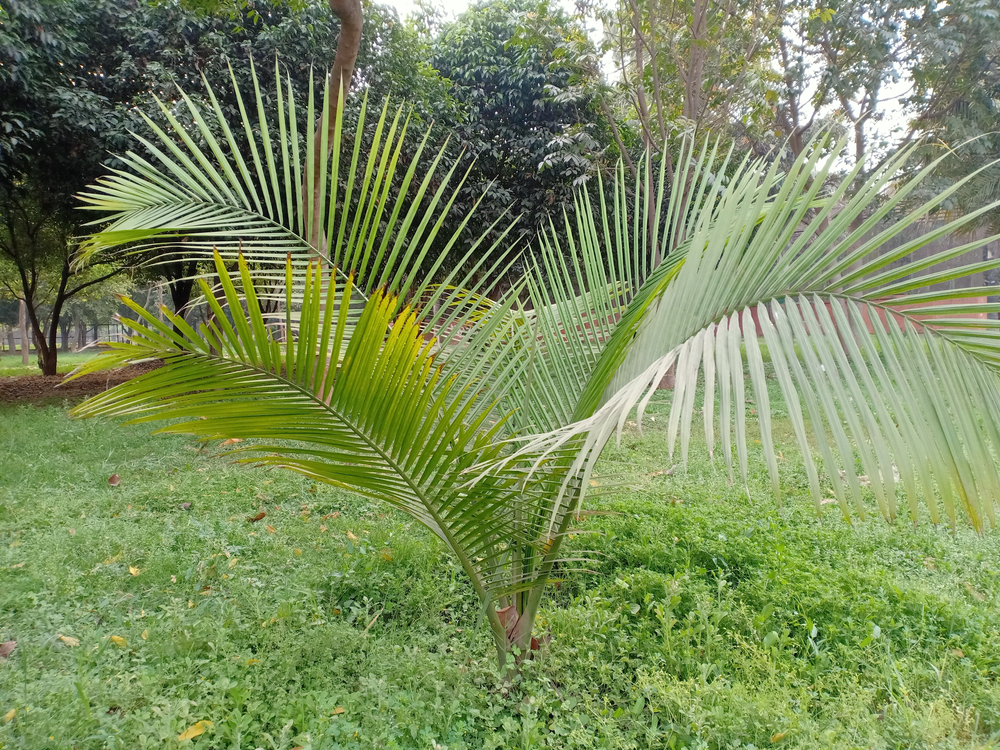
Most commonly grown today as an indoor palm tree, the majesty palm (ravenea rivularis) is known for its long stems with long, softly arching green leaves. It is native to Madagascar and does not produce flowers.
While typically grown indoors in a pot (that grows slowly and reaches no higher than 10 feet), the majesty palm can grow as a normal tree outside where it can reach up to 90 feet.
In both locations, the tree does best in bright, indirect light and with regular watering.
The tree is naturally an understory plant in the Madagascar rainforest, so it likes warmth but prefers things on the cool and damp side rather than direct, dry heat.
8. Royal palm
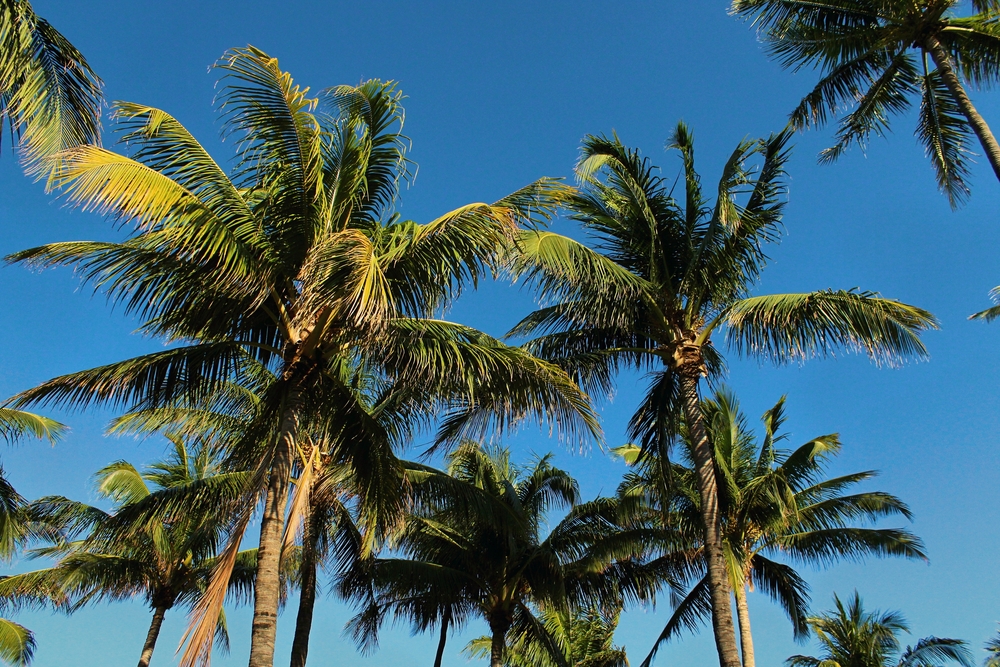
The royal palm (roystonea regia) is widely considered to be among the largest and most visually stunning palm trees.
Contrary to popular belief, the solo name “royal palm” does refer to a specific tree, although there are numerous types of “royal palms” throughout the world.
Average heights fall between 50 and 80 feet, though some up to 125 feet have been recorded.
The royal palm is native to a variety of regions, including southern Florida, Mexico, the Caribbean, and parts of Central America. It is recognizable for its skinny, lean pale-gray or whitish trunk, topped with a crown of long leaf stems.
There is a distinctive bulge right below this crown.
Though widespread as an ornamental palm, the royal palm tree is also used as a source of timber. In more rural regions, its bark and leaves may also be used as roof thatch.
Some cultures use its fruit for medicinal purposes, but there is a lack of scientific evidence to support its efficacy.
9. Caribbean royal palm
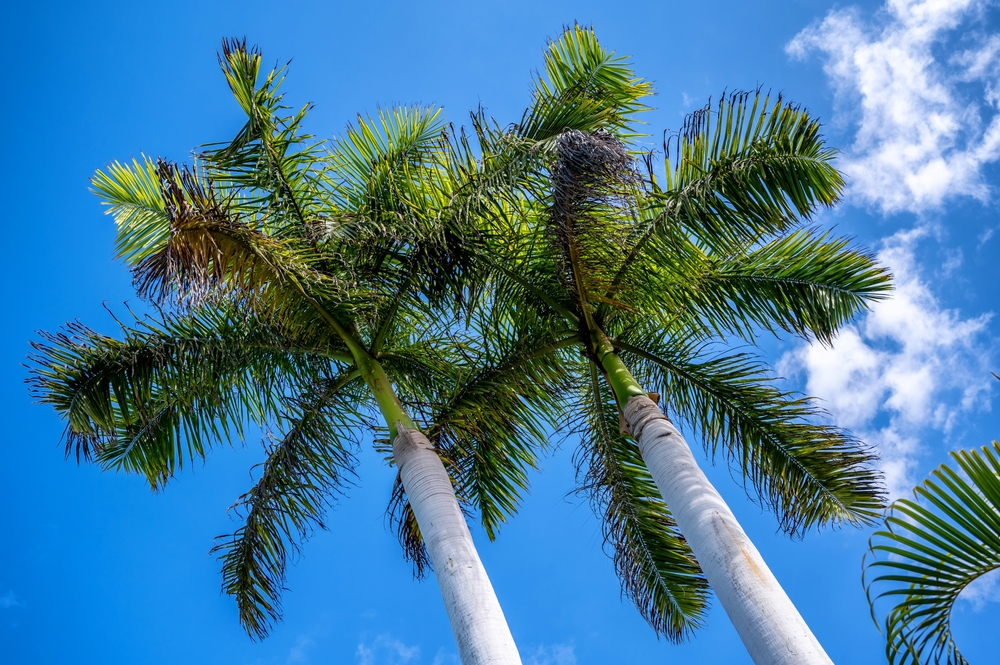
The Caribbean royal palm (roystonea oleracea) is a tall, lean species of palm tree that is native to South American (including Columbia and Venezuela) and southeastern Caribbean islands.
The tree has also been naturalized in various other places, including Guyana, Mauritius, and Reunion. It thrives best in areas with a rainy season.
Larger than many other palm varieties, the Caribbean royal stands at heights up to 130 feet in some areas. The tree’s bushy green leaves can produce white flowers.
Its purplish-black fruit makes up an important part of the diets of numerous tropical birds, including red-bellied macaws and orange-winged parrots.
The Caribbean royal palm is known to be the tallest and considered the “most majestic” of all the royal palm varieties in the world. For this reason, it has been planted as an ornamental tree on the properties of numerous resorts.
10. Sabal palm
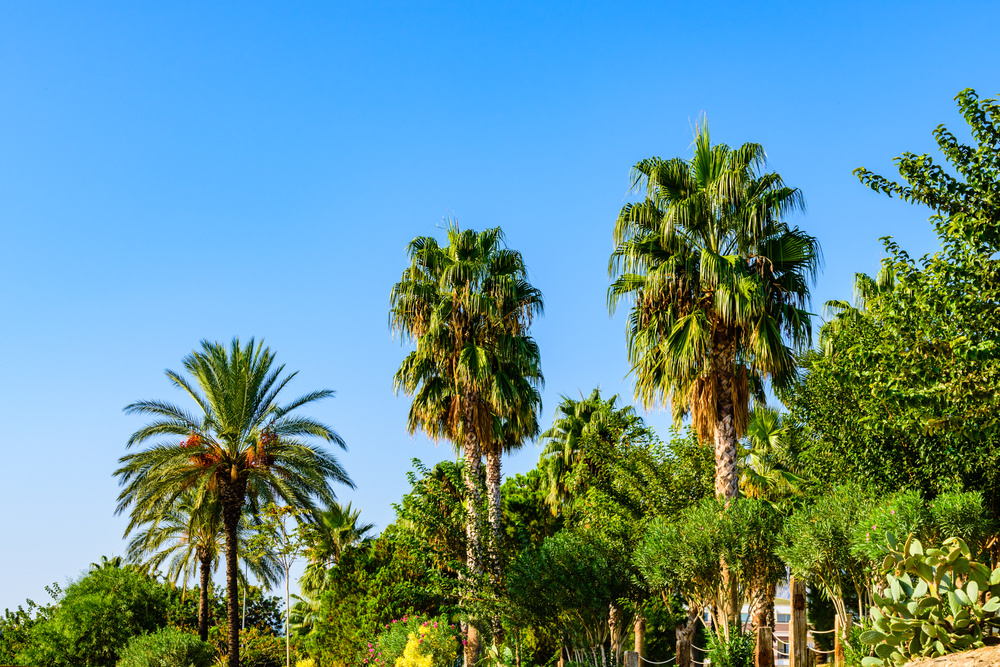
Also referred to as the cabbage palm, common palmetto, or Garfield’s tree, the Sabal palm (Sabal palmetto) holds the honor of being the state tree of both Florida and South Carolina.
In fact, South Carolina is known as “the palmetto state.”
In addition to being native to the southern United States, the Sabal palm also grows naturally in Cuba and other parts of the Caribbean (including Turks and Caicos and the Bahamas).
It can reach full-grown heights between 40 and 50 feet tall, and it is noted for its numerous fan-like leaves that are arranged radially. It also produces small, cabbage-like buds that are eaten as “hearts of palm”
The Sabal palm is also known for being hardy and drought-resistant, tolerating long periods of both standing water and drought.
11. Dwarf Palmetto
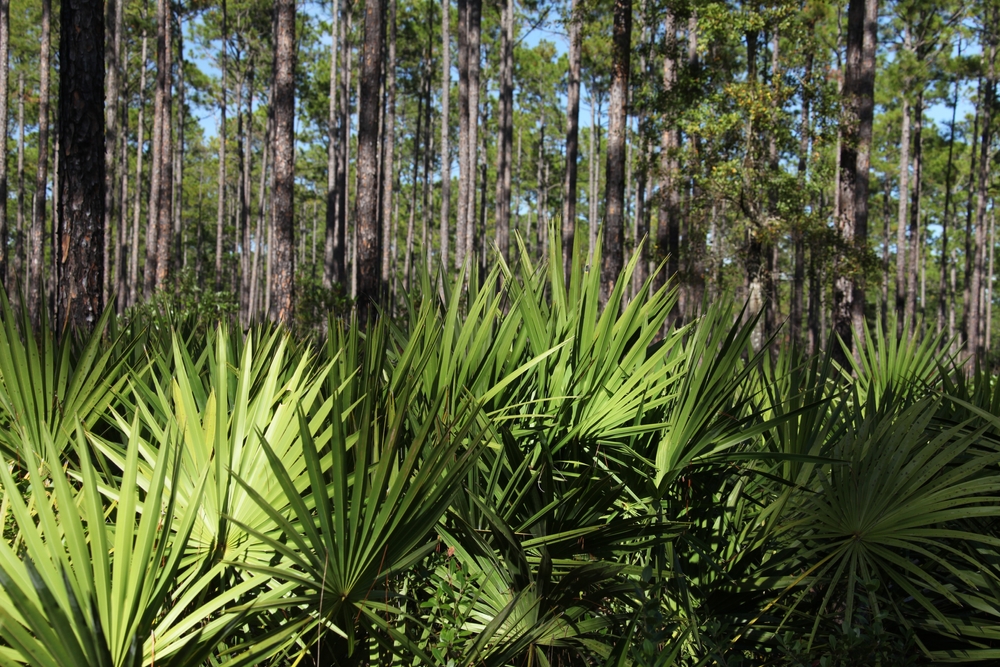
The dwarf palmetto (Sabal minor) is a tiny species of palm tree that is more akin to a shrub. It is native to the southern United States and Mexico but may be grown as a houseplant or landscaping ornament elsewhere.
The palm comes with a short trunk and distinctive fan-like leaves, along with summer flowers that are yellowish-white in appearance.
Slow-growing, the dwarf palmetto can reach up to 9 feet in height if in bright, well-watered conditions.
Due to its small size and natural preference for growing in swamps and other damp, cool places, however, the dwarf palmetto is considered one of the most cold-hardy palms found in the United States.
12. California palm
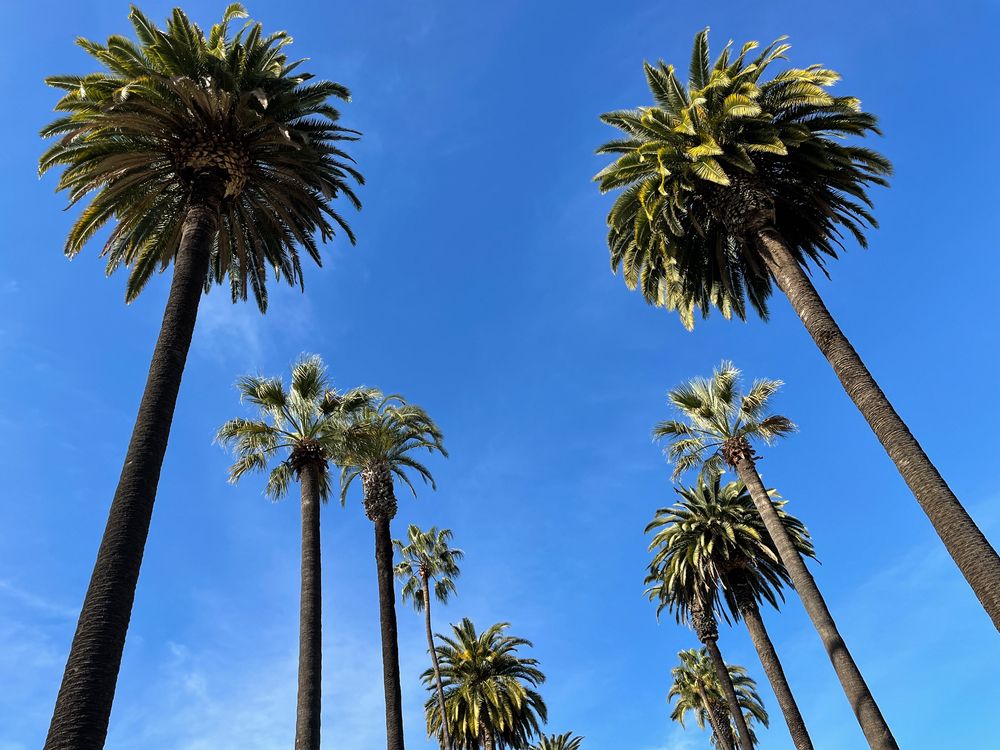
The California palm (Washingtonia filifera) is the kind of tree most often associated with southern California. Indeed, it is the only kind of palm tree that is native to the western United States.
Other names for the tree include the desert fan palm, the California fan palm, and the petticoat palm. Tall and slender, the tree comes with a sturdy, column-like trunk and tufts of waxy leaves shaped outward like fans.
The California palm can reach impressive heights, maximizing at about 59 or 60 feet tall.
In fact, the California palm is one of the tallest palm varieties that are native to the U.S. in general, exceeded in average height only by the Florida royal palm (also known as the Cuban royal palm), which is native to the southeastern part of the country.
13. Bismarck palm

The Bismarck palm (Bismarckia nobilis) is among the most unique-looking palm trees in the world.
In sharp contrast to the green seen on other types of palm, the Bismarck boasts large, striking pale blue-green leaves that can look almost silver in certain lights.
Though the tree is native to Madagascar, it gets its name from Otto von Bismarck, the first chancellor of the German Empire.
Though the Bismarck palm is noted for its unique leaves, there is a lesser-known green variety. Both varieties are fire-resistant and can tolerate more arid regions, though they still require tropical and subtropical climates.
The Bismarck produces small, brown flowers that develop into large brown seeds.
14. Oil palm
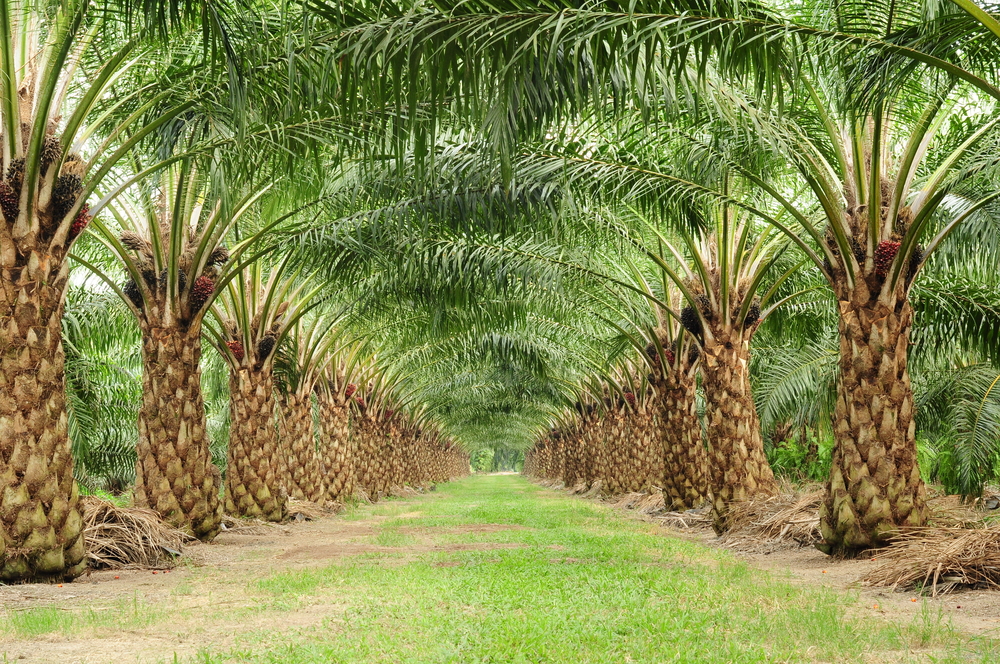
The term “oil palm” actually refers to two different palm tree species: the African oil palm (elaeis guineensis) and the American oil palm (elaeis oleifera).
Both trees are used prominently for oil production for a wide variety of food and skincare products.
Both trees are similar in appearance and grow dense clusters of both leaves and flowers atop single stems. The fruit they bear is warm reddish-brown in appearance and can grow to the size of a small apple or large plum.
Adult trees can reach extreme heights of 66 feet, counting the leaves.
The African oil palm is native to Africa (primarily the west and southwest regions), while the American oil palm is native to both Central and South America.
Both trees transplant well, however, and so they have been transported around the world.
15. Triangle palm
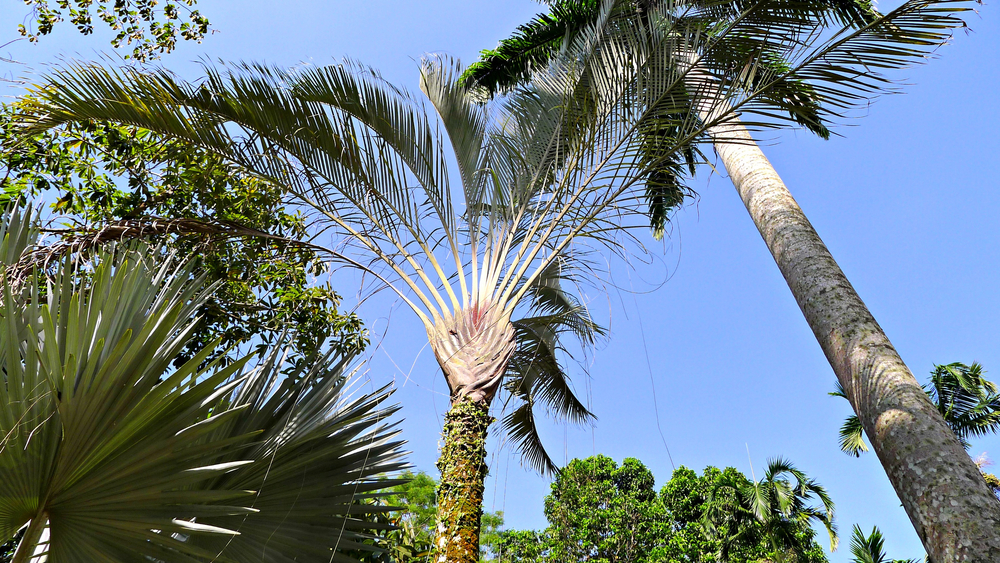
It’s hard to miss the triangle palm (Dypsis decaryi) once you know what to look for.
With lengthy leaf stems arranged in vertical columns and showy yellow-green flowers, its foliage appears to form a bright and large upside-down triangle when viewed from the side.
The tree can also grow to incredibly impressive heights, with over 49 feet recorded in the wild.
The triangle palm is native to Madagascar but has been threatened in recent decades thanks to both harvesting and fires.
In fact, it is estimated that fewer than 1,000 tree specimens remain in their original rainforest habitat, though efforts are underway to grow these numbers.
Compared to other palms, the triangle palm is relatively new on the cultivation front. However, it is starting to become more prominent as an ornamental tree in landscaping around the world.
The tree does not transplant well once rooted, however, and so it is not used in commercial fields.
16. Chinese windmill palm
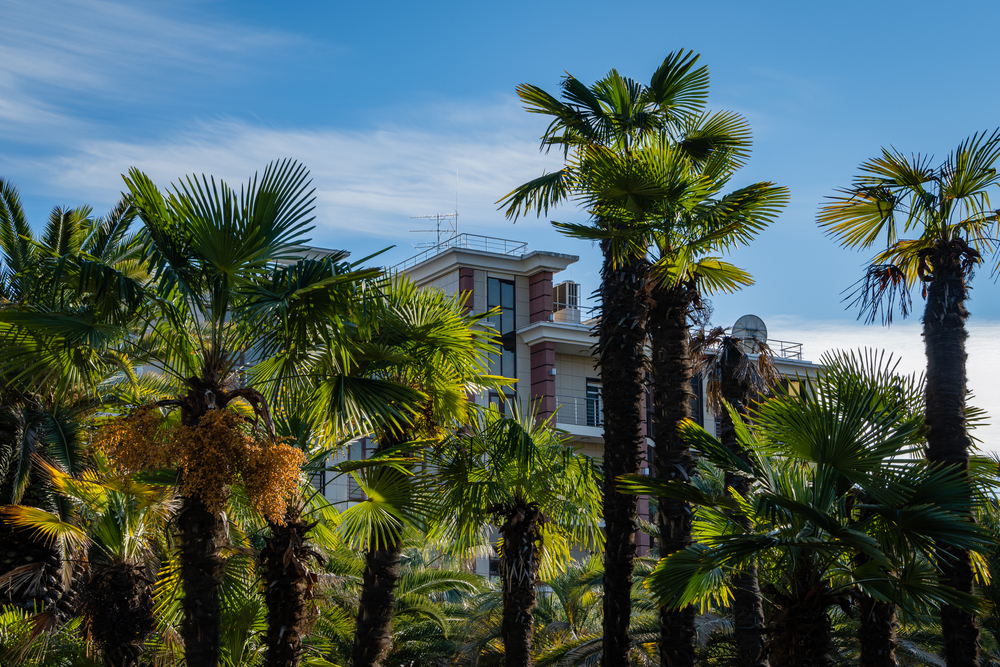
The Chinese windmill palm (Trachycarpus fortunei, T. takil) is characterized by its broad, rounded leafy fans and occasional dark-skinned fruit.
Its trunk is typically covered in coarse, fibrous material that is left over from previous leaf bases. The heights of the adult tree vary wildly, from 6–7 feet to well over 40 feet tall.
Unlike most other palm varieties, the Chinese windmill palm is known to tolerate cool, temperate climates including winters that see occasional snow.
In fact, it is often cited as the world’s most cold-hardy palm tree. Case in point, the Chinese windmill palm is native to the chillier regions of eastern China, Japan, Myanmar, and the Himalayas.
As further proof of its tolerance for chill, the Chinese windmill palm tree has been imported to many other regions of the world with temperatures that dip low in the winter.
In Seattle, Washington, for example, the tree is a popular landscaping plant.
17. Bamboo palm
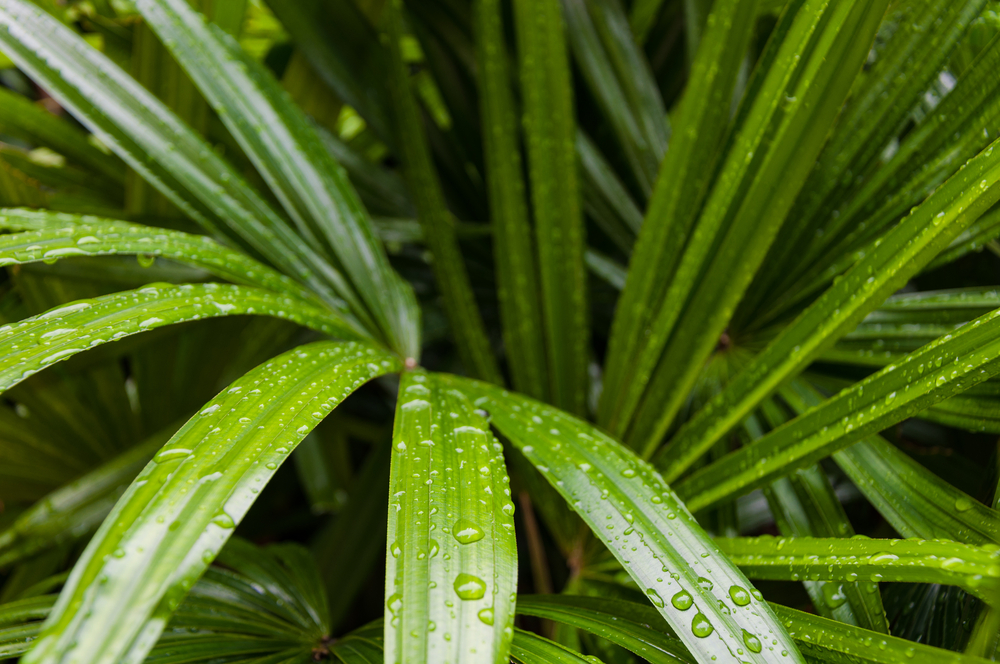
Contrary to what the name may suggest, the bamboo palm (Chamaedorea seifrizii) is not actually bamboo at all. Instead, it is a type of small palm tree native to Mexico and Central America.
Reaching maximum heights between 4 and 12 feet tall, the bamboo palm also fits in well with a variety of home and hotel landscapes.
More notably, bamboo palm stands apart from most palm trees in that it will not only grow but thrive in low light conditions.
This is because, in their native habitat, bamboo palms are forest understory plants and grow closely along the forest floor, far below taller trees that filter the sunlight.
The only real challenge is that bamboo palms require very consistent watering and need to be kept more humid than most houseplants.
Bamboo palms will sprout yellow flowers during the summer months. These flowers can turn into small orange fruits, which turn dark brown or black when ripe.
18. Broadleaf lady palm
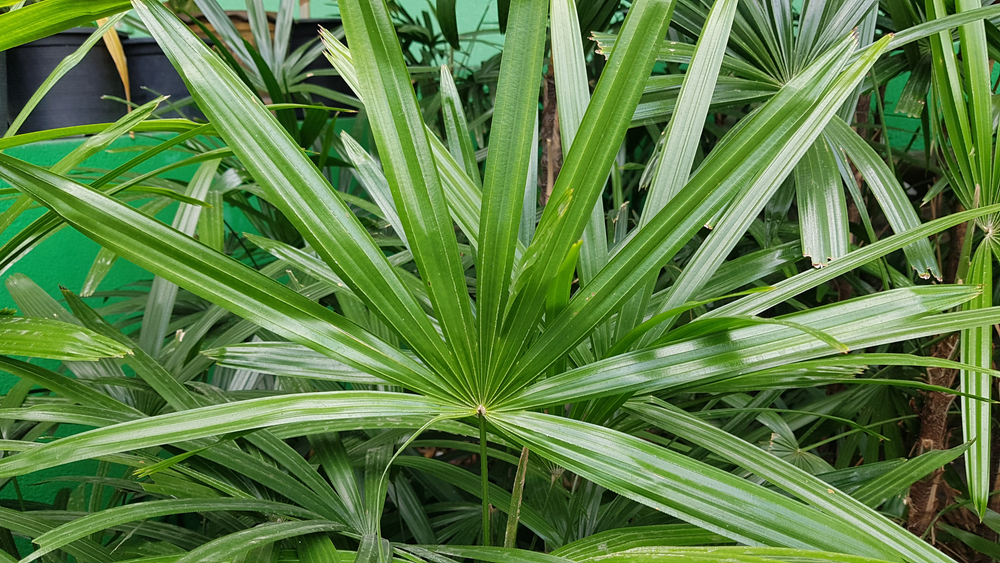
The broadleaf lady palm (rhapis excelsa) is a rare exception to most palm varieties in that it doesn’t actually exist naturally in the wild.
A type of fan palm with long, pointed leaves that resemble thick needles, the broadleaf lady palm was cultivated in China from other existing palm species.
The palm has become a popular house and garden plant thanks to its easy care that can withstand periods of drought.
It’s worth noting that there are many different types of broadleaf lady palm, most noted for their varying color patterns (some are solid green, while others may have a yellowish stripe or white pattern).
Some varieties are rare and highly sought-after by plant collectors around the world. Though it doesn’t always flower, the broadleaf lady palm can produce small yellow flowers that appear fleshy and thick in texture.
19. Foxtail palm
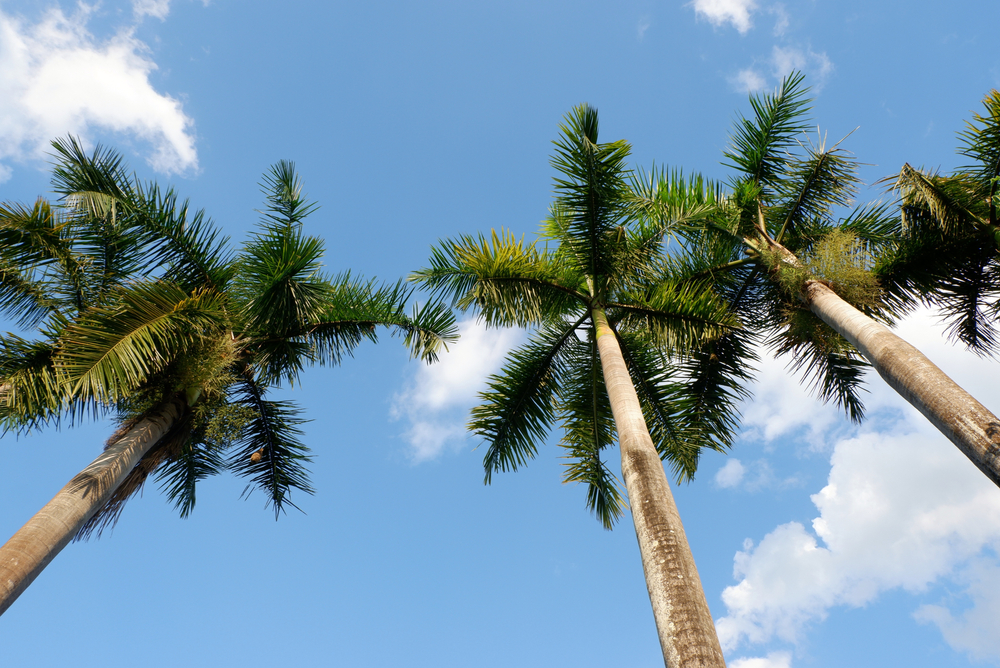
Durable and tolerant of a wide variety of soils, the foxtail palm (wodyetia bifurcata) has become extremely popular as an ornamental palm tree across the globe.
The tree has roots that run deep and help make it resistant to extremely windy conditions and drought, making it a popular choice for a wide variety of properties.
The foxtail palm is also popular because it is fast-growing and can reach impressive heights faster than most other palm varieties.
Native to Queensland, Australia, the foxtail palm is tall and lean (mature heights reach up to 30 feet) with a pale trunk and long, elegant “fluffy” green palm fronds that somewhat resemble the tail of a fox.
The tree bears small white flowers and fruit that start green but mature into orange-red.
20. Ruffled fan palm
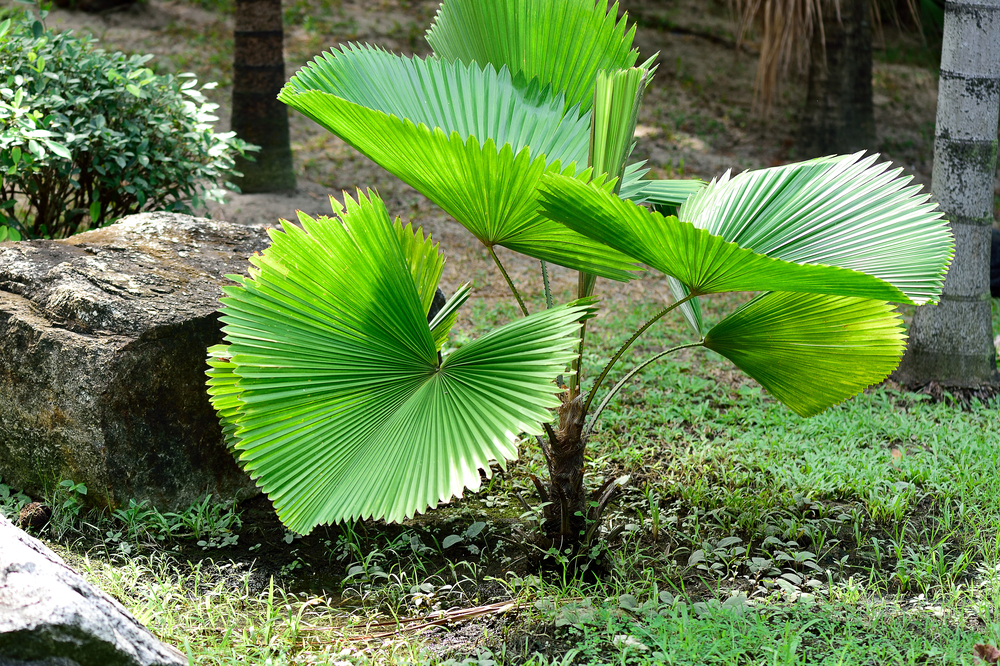
It’s hard to mistake the ruffled fan palm (licuala grandis) for a different kind of palm tree. Due to its broad fans with un-separated leaflets, however, young ruffled fan palms may be mistaken for smaller plants with broad leaves.
When the ruffled fan palm’s leaf fans become fully grown, they can crease easily in the wind and take on a further “ruffled” appearance.
The ruffled fan palm is native to the rainforests of the Solomon Islands and Vanuatu, a Southeast Asian island located distantly off the eastern coast of Australia.
The palm species has not become as widespread as a transplant as other palms, but it has been found in zoos and botanic gardens around the world.
Highly sensitive to cold and frost, the ruffled fan palm thrives best in wet and humid environments.
Where can I see the most palm tree diversity?
Palm trees are most commonly associated with tropical regions, which is where many people head when they want to see them.
But what if you want to be in a place where you can see a lot of different kinds of palm trees? As it turns out, a tropical island isn’t necessarily the place to head.
Palm diversity thrives strongest in lowland forests with high levels of precipitation. Specifically, the areas with the most diverse quantities of palm trees include South America, the South Pacific, and southern Asia.
If counting the Caribbean as a whole rather than looking at individual islands, it too boasts impressive palm tree diversity.
For those looking for sheer volume of palm trees, Africa (and the Middle East) has the greatest amount of palm trees overall. Not coincidentally, Africa also happens to be the world’s leading producer of palm oil.


